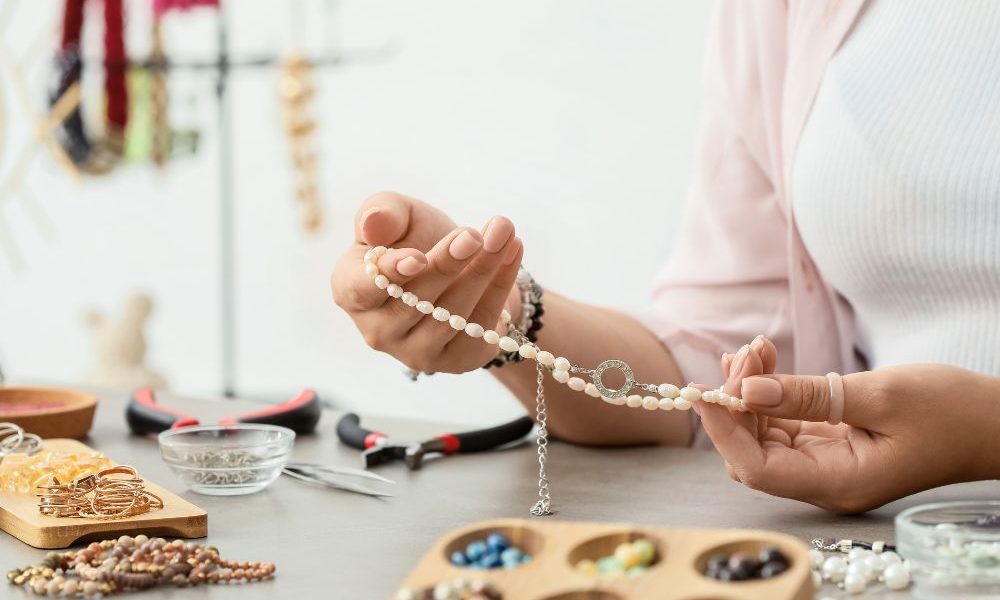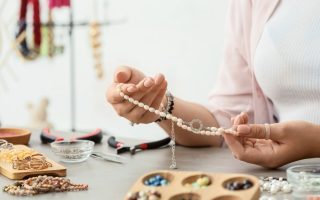Jewelry is much more than just adornment. It is a tangible manifestation of our cultural and personal identity, reflecting the social, economic, and artistic currents of each era. From ancient times to the modern day, the evolution of jewelry design tells a fascinating story of human civilization. This article explores the significant milestones in the history of jewelry design, showcasing how changing tastes, values, and technologies have shaped this timeless art form.
Ancient Jewelry: Symbols of Power and Status
Early Beginnings
The history of jewelry design dates back to ancient civilizations, where early humans used materials like shells, bones, and stones to create simple ornaments. These early pieces were not just decorative but also held significant symbolic meanings, often used as amulets to ward off evil spirits or as status symbols within the tribe.
Egyptian Mastery
“Jewelry is a tangible manifestation of our cultural and personal identity,” says Valerie Steele, Director of the Museum at the Fashion Institute of Technology. Nowhere is this more evident than in ancient Egypt, where jewelry played a crucial role in society. The Egyptians were skilled artisans, creating intricate pieces using gold, gemstones, and glass. Jewelry was worn by both men and women and was often buried with the dead to accompany them into the afterlife.
Mesopotamian and Greek Influences
In Mesopotamia, jewelry design flourished with the use of precious metals and stones. The Greeks further advanced jewelry-making techniques, introducing new forms and motifs, such as intricate gold wreaths and cameos, which were often inspired by mythology and nature.
Personal Anecdote: Inspired by Ancient Designs
I remember visiting a museum exhibit on ancient Egyptian jewelry and being struck by the craftsmanship and beauty of the pieces. It inspired me to buy a necklace with similar designs, which always draws compliments and feels like a connection to a rich history.
Medieval Jewelry: Spiritual and Regal Significance
Religious Influence
During the medieval period, jewelry design was heavily influenced by the Church. Crosses, religious icons, and rosaries were common, reflecting the spiritual devotion of the time. Goldsmiths created intricate pieces adorned with enamel and precious stones, symbolizing both faith and wealth.
Regal Adornments
“Jewelry can be seen as a mirror of human civilization, reflecting the social, economic, and artistic currents of each era,” says Professor Margaret Young-Sanchez, Author of “The Jewelry Handbook.” This is particularly true in the medieval period, where royalty and nobility wore elaborate jewelry to display their power and status. Crowns, brooches, and rings were often set with sapphires, rubies, and emeralds.
Renaissance Jewelry: Rebirth of Art and Innovation
Artistic Flourishing
The Renaissance period marked a significant shift in jewelry design, driven by a renewed interest in art and humanism. Jewelers began to experiment with new techniques and materials, leading to more elaborate and artistic creations. This era saw the introduction of portrait miniatures, cameos, and intricate enamel work.
Personal Anecdote: Renaissance Influence
A trip to Italy introduced me to Renaissance jewelry’s beauty. The intricate designs and vibrant colors inspired me to explore more artistic and unique pieces for my collection, adding a touch of history and elegance to my wardrobe.
Technological Advancements
“The innovative use of materials and techniques in jewelry design has constantly pushed the boundaries of human creativity,” says Dr. Vivienne Becker, Curator of Decorative Arts and Design at the Victoria and Albert Museum. The Renaissance saw significant technological advancements in jewelry making, such as the use of new tools and methods for cutting gemstones, which allowed for more precise and intricate designs.
Baroque and Rococo Jewelry: Extravagance and Ornate Designs
Baroque Splendor
The Baroque period was characterized by extravagance and grandeur, and this was reflected in jewelry design. Pieces were large, bold, and heavily adorned with diamonds and colored gemstones. Jewelers used techniques like filigree and enamel to create intricate and ornate designs.
Rococo Elegance
Following the Baroque period, the Rococo style emerged, characterized by lighter, more playful designs. Jewelry from this era featured delicate curves, asymmetrical shapes, and pastel-colored gemstones. This style was particularly popular in France and influenced jewelry design across Europe.
Victorian Jewelry: Sentimental and Symbolic
Romantic Era
The Victorian era, named after Queen Victoria, was marked by a deep sense of sentimentality and symbolism in jewelry design. Pieces often featured motifs like hearts, flowers, and bows, reflecting the romantic ideals of the time. Lockets and brooches containing hair or miniature portraits of loved ones were common.
Mourning Jewelry
Following Prince Albert’s death, Queen Victoria entered a period of mourning that influenced the entire nation’s fashion. Mourning jewelry, made from black materials like jet and onyx, became popular. These pieces were somber yet elegant, reflecting the period’s emotional depth.
Personal Anecdote: Victorian Heirloom
I inherited a Victorian-era brooch from my grandmother. Its intricate design and sentimental value make it a cherished piece in my collection, reminding me of the enduring beauty and emotional significance of jewelry.
Art Nouveau and Art Deco: Artistic Movements in Jewelry
Art Nouveau: Nature and Fantasy
The Art Nouveau movement at the turn of the 20th century brought a wave of innovation and creativity to jewelry design. Inspired by nature and fantasy, jewelers like René Lalique created pieces with flowing lines, organic shapes, and intricate enamel work. These designs often featured motifs like flowers, insects, and mythical creatures.
Art Deco: Modernity and Glamour
“The evolution of jewelry design reflects the changing tastes, values, and technologies of a society,” notes Dr. Alexandra Bounia, Lecturer in Jewelry History at the University of Edinburgh. The Art Deco movement of the 1920s and 1930s embraced modernity and glamour. Jewelry from this period featured geometric shapes, bold colors, and the use of new materials like platinum and Bakelite. The designs were sleek, elegant, and reflective of the optimism and technological advancements of the era.
Personal Anecdote: Discovering Art Deco
I discovered my love for Art Deco jewelry while browsing a vintage shop. The bold geometric designs and vibrant colors stood out, leading me to purchase a stunning Art Deco ring that remains one of my favorite pieces.
Modern and Contemporary Jewelry: Innovation and Diversity
Post-War Innovation
Following World War II, jewelry design saw a resurgence of creativity and innovation. Designers experimented with new materials and techniques, leading to unique and diverse creations. The 1950s and 1960s saw the rise of costume jewelry, making fashionable pieces accessible to a wider audience.
Contemporary Trends
Today, jewelry design is marked by a blend of traditional craftsmanship and modern innovation. Contemporary designers like Tiffany & Co., Cartier, and independent artisans create pieces that cater to diverse tastes and styles. Sustainable and ethical practices have also become significant, with consumers increasingly seeking eco-friendly and conflict-free jewelry.
Personal Anecdote: Embracing Contemporary Styles
I enjoy mixing contemporary jewelry with vintage pieces to create a unique look. A modern, minimalist bracelet paired with an antique ring adds a personal touch to my style, reflecting both my appreciation for history and love for innovation.
The Role of Jewelry in Modern Society
Cultural Significance
Jewelry continues to hold cultural significance in modern society. It marks important life events such as weddings, anniversaries, and graduations, serving as a symbol of love, commitment, and achievement. Across different cultures, jewelry is used in rituals and ceremonies, reflecting the diverse traditions and values of various communities.
Expression of Individuality
Today, jewelry is a powerful tool for self-expression. “Jewelry is a wearable art form that can add interest, sparkle, and sophistication to any outfit,” says Lisa Levinson, Fashion Director of The Zoe Report. Whether it’s a statement necklace, a pair of bold earrings, or a personalized bracelet, jewelry allows individuals to express their unique style and personality.
Ethical and Sustainable Practices
As awareness of environmental and social issues grows, there is an increasing demand for ethical and sustainable jewelry. Consumers are looking for pieces that are made from recycled materials, conflict-free diamonds, and fair-trade gemstones. This shift is driving the industry towards more responsible and transparent practices.
Personal Anecdote: Choosing Ethical Jewelry
When I decided to buy an engagement ring, I researched extensively to find a jeweler that offered ethically sourced diamonds. Knowing that the ring was both beautiful and ethically made added an extra layer of meaning to such a significant purchase.
The Future of Jewelry Design
Technological Advancements
Technology continues to revolutionize jewelry design. Techniques such as 3D printing allow for intricate and customized designs that were once impossible to achieve. This innovation opens up new possibilities for creativity and personalization in jewelry making.
Revival of Vintage Styles
There is a growing appreciation for vintage and antique jewelry, with many designers drawing inspiration from past eras. This trend reflects a desire for unique and timeless pieces that tell a story and have historical significance.
Minimalism and Versatility
In response to the fast-paced modern lifestyle, there is a trend towards minimalist and versatile jewelry. Pieces that can be worn in multiple ways or styled with different outfits are becoming increasingly popular. This approach emphasizes quality over quantity, focusing on timeless designs that endure.
Personal Anecdote: Embracing Minimalism
I’ve recently started focusing on a minimalist jewelry collection, choosing versatile pieces that can be worn every day. This shift has helped me appreciate the craftsmanship and simplicity of each piece, making my jewelry feel more special and meaningful.
Conclusion
The evolution of jewelry design is a testament to human creativity, innovation, and cultural diversity. From the simple ornaments of ancient times to the sophisticated and varied designs of today, jewelry has always been more than just adornment. It reflects our history, values, and personal stories.
Understanding the history and significance of jewelry can deepen our appreciation for these beautiful objects. Whether you’re drawn to the intricate designs of the past or the sleek, modern styles of today, there is a piece of jewelry out there that can express who you are and what you value.
As we look to the future, the jewelry industry continues to evolve, embracing new technologies and sustainable practices. This ongoing transformation ensures that jewelry will remain a cherished and meaningful part of our lives for generations to come.

